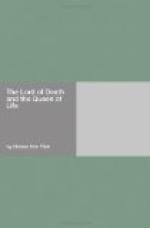The inviting-looking valley was now less than a hundred miles below. Inviting, however, only in outline; in color it was a grayish buff, scorched and forbidding. The hills were yellower, and an alkali white on their summits.
“Do either of you fellows see anything green?” demanded the engineer, a little later. They were silent; each had noticed long before, that not even near the poles was there the slightest sign of vegetation.
“No chance unless there’s foliage,” muttered the doctor, half to himself. The builder asked what he meant. He explained: “So far as we know, all animal life depends upon vegetation for its oxygen. Not only the oxygen in the air, but that stored in the plants which animals eat. Unless there’s greenery—”
He paused at a low exclamation from Smith. The engineer’s eyes were fixed, in wonder and excitement, upon that part of the valley which lay at the joint of the “L” below them. It was perhaps six miles across; and all over the comparatively smooth surface jutted dark projections. Viewed through the glasses, they had a regular, uniform appearance.
“By Jove!” ejaculated the doctor, almost in awe. He leaned forward and scrubbed the dead-light for the tenth time. All four men strained their eyes to see.
It was the architect who broke the silence which followed. The other three were content to let the thrill of the thing have its way with them. Such a feeling had little weight with the expert in archeology.
“Well,” he declared jubilantly in his boyish voice, “either I eat my hat or that’s a genuine, bona fide city!”
As swiftly as an elevator drops, and as safely, the cube shot straight downward. Every second the landscape narrowed and shrunk, leaving the remaining details larger, clearer, sharper. Bit by bit the amazing thing below them resolved itself into a real metropolis.
Within five minutes they were less than a mile above it. Smith threw on more current, so that the descent stopped; and the cube hung motionless in space.
For another five minutes the four men studied the scene in nervous silence. Each knew that the others were looking for the same thing—some sign of life. A little spot of green, or possibly something in motion—a single whiff of smoke would have been enough to cause a whoop of joy.
But nobody shouted. There was nothing to shout about. Nowhere in all that locality apparently was there the slightest indication that any save themselves were alive.
Instead, the most extraordinary city that man had ever laid eyes upon was stretched directly beneath. It was grouped about what seemed to be the meeting-point of three great roads, which led to this spot from as many passes through the surrounding hills. And the city seemed thus naturally divided into three segments, of equal size and shape, and each with its own street system.
For they undoubtedly were streets. No metropolis on earth ever had its blocks laid out with such unvarying exactness. This Mercurian city contained none but perfect equilateral triangles, and the streets themselves were of absolutely uniform width.




